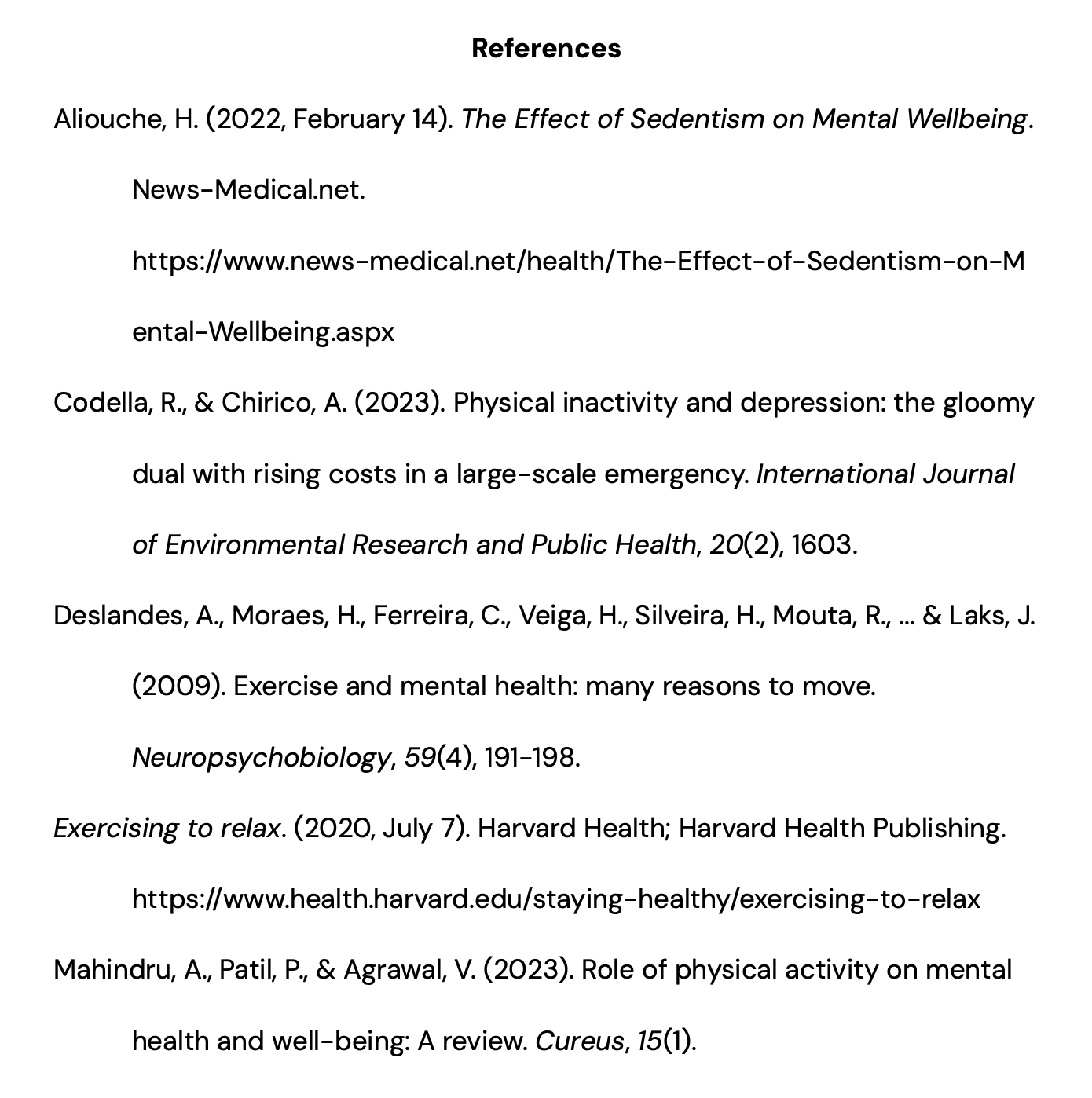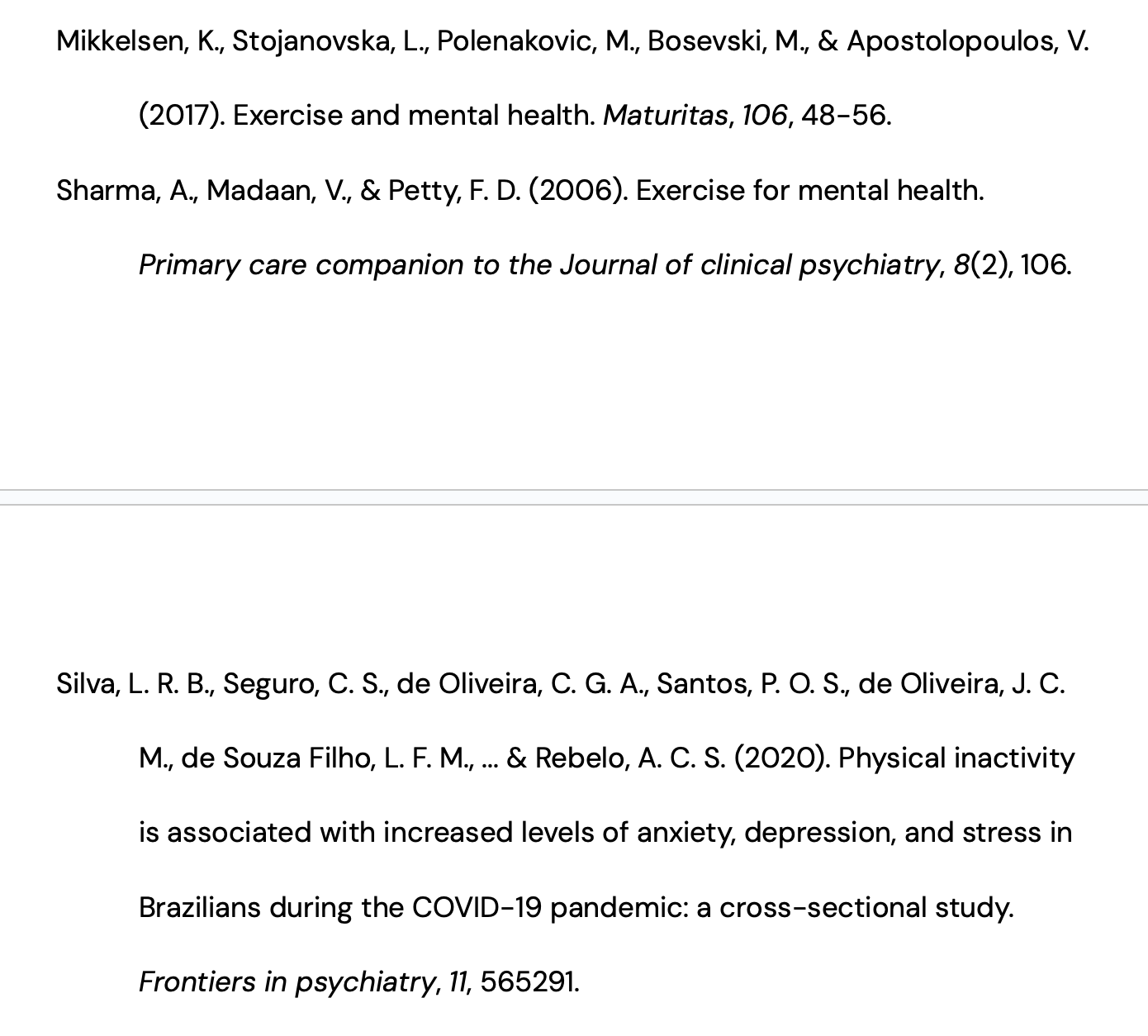Exercise and Mental Health
Abstract
Human health experts have long known the importance of exercise on physical well-being. But while we often stereotype exercise as being good for the body, it’s also extremely beneficial for the brain. By boosting levels of certain chemicals and giving the body natural anti-stress and antidepressant effects, physical activity improves mood and wellbeing. In fact, physical activity is so important that too little of it has a multitude of negative consequences on a person’s mental and emotional well-being. Various studies, including ones conducted during the COVID-19 pandemic, have proven just this. Luckily, there are numerous ways to reap the benefits of exercise, with diverse options that can be suitable to all kinds of preferences and lifestyles. Some of these options are intensive, while others are fairly mild but still positively impact mental health. All in all, it is clear that maintaining a consistent exercise routine throughout life is vital to one’s mental health.
What are the Mental Health Benefits of Exercise?
Now, there are various ways in which exercise boosts mental well-being. From a chemical perspective, physical activity releases hormones called endorphins. These chemicals are known to have painkilling effects and improve mood, and these characteristics are the basis of the “endorphin hypothesis” ("Exercising to relax", 2020; Mahindru et al., 2023). To go into detail, endorphins can reduce feelings of stress, and can even improve anxiety and depression (Mikkelsen et al., 2017). This phenomenon is often referred to as the “runner’s high”, a term which describes the feelings of euphoria and internal peace often felt after a moderate to intense workout (Mikkelsen et al., 2017).
Aside from just endorphins, exercise aids in the release of neurotransmitters like serotonin, dopamine, acetylcholine, and norepinephrine (Deslandes et al., 2009). These chemicals are all known to promote mental wellbeing and positive emotions (Deslandes et al., 2009). While these chemicals all get raised during physical activity, it’s also important to note that stress hormones, namely adrenaline and cortisol, are lowered, which contributes to a feeling of optimism after a workout ("Exercising to relax", 2020). Similarly, during physical activity the body releases more opioids and endocannabinoids, which have properties that are associated with “pleasure, anxiolytic effects, sleepiness, and reduced pain sensitivity” (Codella and Chirico, 2023).
A review of the current literature suggests that if people struggling with depression engage in physical exercise three times a week, they can mitigate their depressive episodes by 25% (Codella and Chirico, 2023). Self-esteem and social withdrawal issues are also often alleviated by moderate levels of exercise (Sharma et al., 2006). Specifically, researchers have pinpointed that frequent physical activity boosts performance of hypothalamus-pituitary-adrenal (HPA) axis, which lessens levels of the stress hormone cortisol (Sharma et al., 2006).
What are the Harms of Inactivity?
Physical activity is in fact so important for the brain that without it, serious concerns can arise. A sedentary lifestyle - defined as being when an individual has minimal movement and therefore minimal energy expenditure - poses a multitude of mental health risks. Sadly, around 30% of the world’s population fail to meet the recommended physical activity standards, as determined by the World Health Organization (Codella and Chirico, 2023). This is partly due to the fact that many modern day activities - such as watching television and using a computer - are sedentary behaviors (Aliouche, 2020). All this lack of movement results in people feeling more emotionally and psychologically distressed (Silva et al., 2020).
In one study, 284 adults were surveyed during the COVID-19 pandemic to see how discrepancies in activity levels impacted mental health reports (Aliouche, 2020). Those who reported more sedentary behavior had a much lower subjective wellbeing than those who reduced sedentary activity (Aliouche, 2020). Another study suggests that inactivity can increase risk of developing anxiety, depression, and high stress levels by roughly 118%, 152%, and 75%, respectively (Silva et al., 2020). In fact, being overly sedentary increases risk of developing major depression, with 22% of elderly people experiencing major depression due to the prevalence of sedentary lifestyles in older people (Deslandes et al., 2009). These findings reveal how heavily inactivity correlates with poorer mental health.
How to Stay Active
While it may be intuitive to assume the benefits discussed here are solely the result of intense exercise, it only takes moderate amounts of activity to see results. In fact, any sort of physical exercise is better than none when it comes to mental health, and doing it regularly can even have effects as powerful as some pharmacological and psychotherapeutic treatments (Mikkelsen et al., 2017).
The World Health Organization advocates for people to engage in at least 150 minutes of physical activity per week (Silva et al., 2020). These 150 minutes can be distributed in a variety of ways. For example, simply walking for 30 minutes three days a week is seen as enough (Sharma et al., 2006). Moreover, doing 20-40 minutes of aerobic exercise provides a mood boost and cuts anxiety levels for hours afterward (Mikkelsen et al., 2017). Similarly, 15-25 minutes of biking/cycling per week is therapeutic for people experiencing depressive symptoms.
Running, swimming, and biking are great options to maximize the benefits discussed above (Sharma et al., 2006; Codella and Chirico, 2023). Strength training increases testosterone levels, which can help elevate mood (Deslandes et al., 2009). Likewise, cardio can act as a natural antidepressant (Codella and Chirico, 2023). Additionally, less intuitive forms of physical activity - like dancing and gardening - are just as good (Sharma et al., 2006). Autoregulation exercises, in which stress responses are combatted with calming repose, are great for mitigating everyday stress levels ("Exercising to relax", 2020). For instance, yoga is a form of activity that is particularly recommended to those dealing with anxiety and depression, especially because it is contained, has low risk for negative consequences, and offers soothing effects (Mahindru et al., 2023).
Health care providers even have opportunities to take advantage of the benefits of activity when creating treatment plans for patients suffering from mental health disorders. For example, implementing it alongside psychotherapeutic and pharmacological treatments is fairly simple and can enhance the patient’s overall recovery experience (Mikkelsen et al., 2017). Overall, involving targeted workouts in treatment plans can aid patients’ mental health, which is crucial to a successful recovery (Sharma et al., 2006).
Conclusion
In an ever-innovating world, sedentary lifestyles have quickly become a norm. However, the toll this takes on society’s mental health reveals the flaws of this norm. Thus, it becomes apparent that those working in health industries need to advocate for a more active society, and individuals need to understand the impacts of exercise and aim to maximize its benefits.

